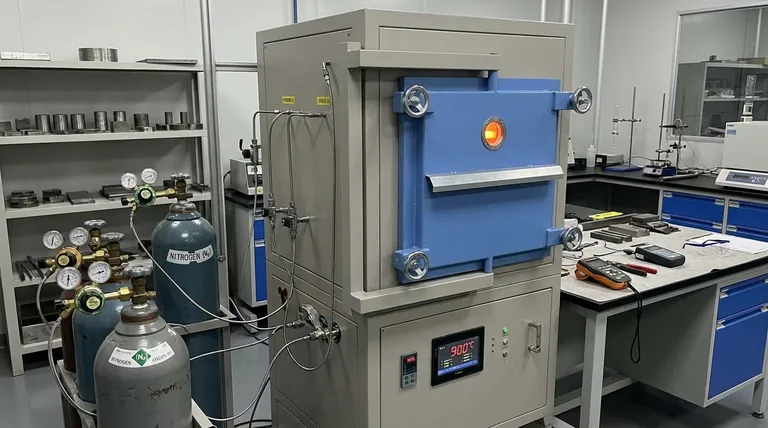The primary gases used in heat treatment are inert or non-reactive gases, with nitrogen being the most common. These gases create a controlled, protective atmosphere inside the furnace, preventing the hot metal surface from reacting with harmful elements in the air, such as oxygen.
The fundamental purpose of using gases in heat treatment is not to alter the metal itself, but to shield it. This protective atmosphere prevents undesirable chemical reactions like oxidation (scaling) and decarburization that would otherwise compromise the component's surface quality and mechanical properties.

The Core Problem: Why a Protective Atmosphere is Necessary
At the high temperatures required for heat treatment, metals become highly reactive. Exposing them to ambient air would cause significant damage, rendering the process ineffective.
The Threat of Oxygen (Oxidation)
When steel is heated, oxygen in the air rapidly reacts with its surface. This reaction forms an iron oxide layer, commonly known as scale.
This scale is undesirable as it alters the component's dimensions, creates a poor surface finish, and must be removed through costly secondary operations like sandblasting or pickling.
The Threat of Carbon Loss (Decarburization)
For many steels, the carbon content near the surface is critical for achieving the desired hardness. Oxygen can react with this carbon, pulling it out of the steel's surface.
This loss of carbon, known as decarburization, leaves a soft, weak layer on the component, severely compromising its wear resistance and fatigue life.
Common Gases and Their Roles
The choice of gas depends on the material being treated, the temperature, and the desired outcome. The goal is always to displace the air inside the furnace with a predictable, non-reactive atmosphere.
Nitrogen (N₂): The Industry Workhorse
Nitrogen is the most widely used gas for creating a protective atmosphere. It is effective at preventing oxidation for a vast range of heat treatment applications.
Because it makes up roughly 78% of the air we breathe, it is relatively inexpensive to produce in high-purity forms, making it the most cost-effective option for general-purpose heat treating of steels.
Argon (Ar): For Highly Reactive Metals
Argon is a noble gas, meaning it is truly inert and will not react with other elements even at very high temperatures.
While more expensive than nitrogen, argon is essential for heat treating highly reactive metals like titanium, certain grades of stainless steel, or superalloys that could form nitrides if processed in a nitrogen atmosphere.
Understanding the Trade-offs
Selecting a protective atmosphere is a balance between technical requirements and operational costs. Simply flooding a furnace with gas is not enough.
Cost vs. Purity
The primary trade-off is between the cost of the gas and the level of protection required. Nitrogen is sufficient for the majority of ferrous metals.
Investing in more expensive argon only makes sense when the material's value and sensitivity to reaction justify the added cost.
Furnace Integrity and Flow Rate
The effectiveness of any protective atmosphere depends on the furnace's ability to remain sealed. Leaks that allow air to enter will contaminate the atmosphere and cause oxidation, regardless of the gas used.
Properly managing gas flow rates is also critical. You need enough flow to purge the furnace of air and maintain positive pressure to prevent ingress, but excessive flow is simply a waste of gas and money.
Making the Right Choice for Your Application
Your material dictates the necessary level of atmospheric protection.
- If your primary focus is general heat treating of carbon and alloy steels: Nitrogen provides excellent and cost-effective protection against oxidation and decarburization.
- If your primary focus is processing reactive metals like titanium or specific high-alloy stainless steels: Argon is the required choice to ensure a completely inert environment and prevent unwanted reactions.
Ultimately, choosing the correct protective atmosphere is a critical decision to guarantee the surface integrity and performance of your heat-treated components.
Summary Table:
| Gas | Primary Use | Key Characteristic |
|---|---|---|
| Nitrogen (N₂) | General heat treating of carbon & alloy steels | Cost-effective; prevents oxidation/decarburization |
| Argon (Ar) | Heat treating reactive metals (e.g., titanium, specific stainless steels) | Truly inert; prevents nitride formation and oxidation |
Ensure your heat treatment process delivers flawless results. The right protective atmosphere is critical for preventing surface defects and preserving the mechanical properties of your components. KINTEK specializes in providing the lab equipment and expert support you need to create the perfect controlled environment for your specific materials.
Contact our experts today to discuss your application and find the most efficient and cost-effective gas solution for your laboratory.
Visual Guide

Related Products
- 1700℃ Controlled Atmosphere Furnace Nitrogen Inert Atmosphere Furnace
- 1400℃ Controlled Atmosphere Furnace with Nitrogen and Inert Atmosphere
- Controlled Nitrogen Inert Hydrogen Atmosphere Furnace
- 1200℃ Controlled Atmosphere Furnace Nitrogen Inert Atmosphere Furnace
- Vertical Laboratory Tube Furnace
People Also Ask
- What provides an inert atmosphere? Achieve Safety and Purity with Nitrogen, Argon, or CO2
- How we can develop inert atmosphere for a chemical reaction? Master Precise Atmospheric Control for Your Lab
- What is an example of an inert atmosphere? Discover the Best Gas for Your Process
- What is the role of an atmosphere-controlled tube furnace in Cu-Mo sintering? Achieve High-Purity Densification
- Why nitrogen is used in furnace? A Cost-Effective Shield for High-Temperature Processes



















